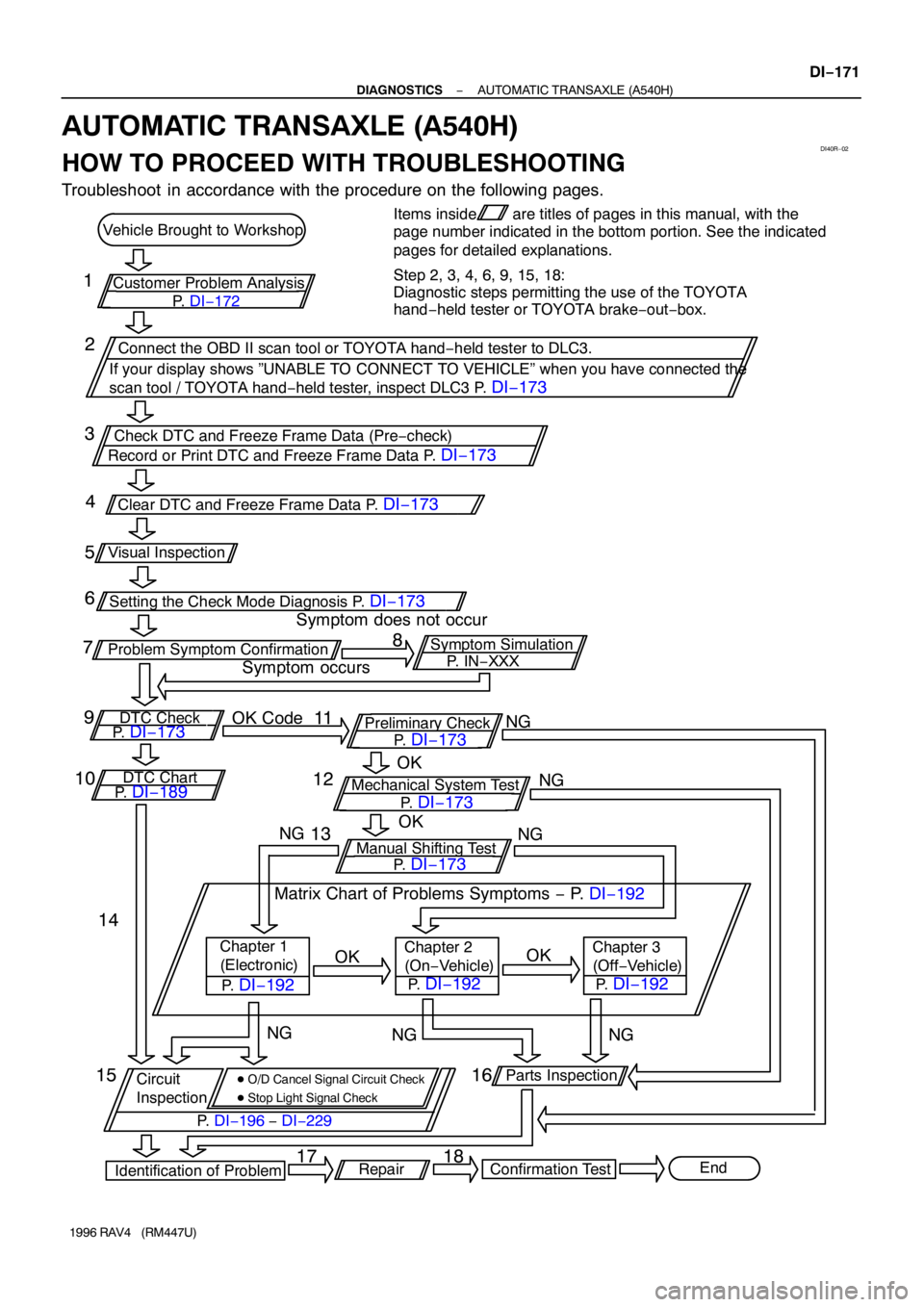Page 478 of 1354
Q08076
DI−158
− DIAGNOSTICSAUTOMATIC TRANSAXLE (A241E)
1996 RAV4 (RM447U)
2 Check park/neutral position switch.
PREPARATION:
Disconnect the park/neutral position switch connector.
CHECK:
Check the continuity between each terminal shown below when
the shift lever is moved to each position.
Shift positionTerminal NO. to continuity
P2 − 75 − 6
R2 − 8
N2 − 95 − 6
D2 − 10
22 − 3
L2 − 4
NG Replace park/neutral position switch.
OK
3 Check harness and connector between battery and park/neutral position switch,
and ECM and park/neutral position switch (See page IN−30).
NG Repair or replace harness and connector.
OK
Check and replace ECM.
Page 481 of 1354
Q08869
Junction Connector Fuse Block
FL Block Junction Connector
O/D Main Switch*
O/D Main switch
Contacts go open with switch pushed in.
Contacts go closed with switch pushed once again. *:
− DIAGNOSTICSAUTOMATIC TRANSAXLE (A241E)
DI−161
1996 RAV4 (RM447U)
O/D Main Switch & O/D OFF Indicator Light Circuit
CIRCUIT DESCRIPTION
The O/D main switch contacts go open when the switch is pushed in and go closed when it is pushed once
again. In O/D main switch OFF position, the O/D OFF indicator lights up, and the ECM prohibits shifting to
O/D.
WIRING DIAGRAM
DI40N−02
Page 486 of 1354
Q05352
Cruise Control ECU
C16
ECM
4 − 6 V
9
ODOD1
Y−B20
E6
D02210
ON
OD1
DI−166
− DIAGNOSTICSAUTOMATIC TRANSAXLE (A241E)
1996 RAV4 (RM447U)
O/D Cancel Signal Circuit
CIRCUIT DESCRIPTION
While driving uphill with cruise control activated, in order to minimize gear shifting and provide smooth cruis-
ing, O/D may be prohibited temporarily under some conditions.
The cruise control ECU sends O/D cur signals to the ECM as necessary and the ECM cancels O/D shifting
until these signals are discontinued.
WIRING DIAGRAM
INSPECTION PROCEDURE
1 Check voltage between terminal OD1 of ECM and body ground.
PREPARATION:
Turn the ignition switch ON.
CHECK:
Measure the voltage between terminal OD1 of the ECM and
body ground.
OK:
Voltage: 4 − 6 V
OK Proceed next circuit inspection shown on prob-
lem symptoms table (See page DI−141).
NG
DI40O−01
Page 488 of 1354
Q08867
Junction Connector
Fuse Block
FL Block
DI−168
− DIAGNOSTICSAUTOMATIC TRANSAXLE (A241E)
1996 RAV4 (RM447U)
Pattern Select Switch Circuit
CIRCUIT DESCRIPTION
The ECM memory contains the shift programs for the NORMAL and POWER patterns, 2 position, and L posi-
tion and the lock−up patterns. Following the programs corresponding to the signals from the pattern select
switch, the park/neutral position switch and other various sensors, the ECM switches the solenoid valves
ON and OFF, and control the transmission gear change and the lock−up clutch operation.
WIRING DIAGRAM
INSPECTION PROCEDURE
1 Check operation of PWR indicator light.
CHECK:
Check if the PWR indicator light normally when the pattern select switch is set to NORM and PWR position.
OK:
Pattern select switchPWR indicator light
PWRLight up
NORMGoes off
NG Check and repair PWR indicator light (See page
BE−2).
OK
DI40P−02
Page 491 of 1354

DI40R−02
Vehicle Brought to Workshop
Customer Problem Analysis
Check DTC and Freeze Frame Data (Pre−check)
Record or Print DTC and Freeze Frame Data P.
DI−173
Clear DTC and Freeze Frame Data P. DI−173
Visual Inspection
Setting the Check Mode Diagnosis P.
DI−173
1
Items insideare titles of pages in this manual, with the
page number indicated in the bottom portion. See the indicated
pages for detailed explanations.
Connect the OBD II scan tool or TOYOTA hand−held tester to DLC3.
If your display shows ”UNABLE TO CONNECT TO VEHICLE” when you have connected the
scan tool / TOYOTA hand−held tester, inspect DLC3 P.
DI−173
2
3
4
5
6
Symptom does not occur
Problem Symptom Confirmation8
7Symptom Simulation
P. I N−XXX
Symptom occurs
DTC CheckP. DI−173OK Code11Preliminary Check
P.
DI−173
DTC Chart
P. DI−189Mechanical System Test
P.
DI−173
Manual Shifting Test
P.
DI−173 OK
OK
Chapter 1
(Electronic)Chapter 2
(On−Vehicle)OKChapter 3
(Off−Vehicle)OK Matrix Chart of Problems Symptoms − P. DI−192
Circuit
Inspection� O/D Cancel Signal Circuit Check
� Stop Light Signal Check
NG
Parts Inspection
NG
NGNG
Identification of ProblemRepairConfirmation TestEnd
NG
NG
13NG
15 16
17 18 9
10
P. DI−192
P. DI−196 − DI−229 P. DI−172
12
14
P. DI−192P. DI−192
Step 2, 3, 4, 6, 9, 15, 18:
Diagnostic steps permitting the use of the TOYOTA
hand−held tester or TOYOTA brake−out−box.
− DIAGNOSTICSAUTOMATIC TRANSAXLE (A540H)
DI−171
1996 RAV4 (RM447U)
AUTOMATIC TRANSAXLE (A540H)
HOW TO PROCEED WITH TROUBLESHOOTING
Troubleshoot in accordance with the procedure on the following pages.
Page 492 of 1354
DI40S−01
Transaxle Control
System Check SheetInspector ’s
Name:
Customer ’s Name
Registration No.
Registration Year
Frame No.
Date Vehicle
Brought InOdometer Readingkm
mile / /
/ /
Date Problem
Occurred
Frequency Prob-
lem Occurs?/ /
� Continuous � Intermittent ( times a day)
Symptoms
� Vehicle does not move ( � Any position � Particular position )
� No up−shift ( � 1st → 2nd � 2nd → 3rd � 3rd → O/D )
� No down−shift ( � O/D → 3rd � 3rd → 2nd � 2nd → 1st )
� Lock−up malfunction
� Shift point too high or too low
� Harsh engagement ( � N → D � Lock−up � Any drive position )
� Slip or shudder
� No kick−down
� Others
Check ItemMalfunction
Indicator Lamp
DTC Check
1st Time
2nd Time� Normal code � Malfunction code (Code ) � Normal� Remains ON
� Normal code � Malfunction code (Code ) DI−172
− DIAGNOSTICSAUTOMATIC TRANSAXLE (A540H)
1996 RAV4 (RM447U)
CUSTOMER PROBLEM ANALYSIS CHECK
Page 497 of 1354

− DIAGNOSTICSAUTOMATIC TRANSAXLE (A540H)
DI−177
1996 RAV4 (RM447U)
4. CHECK FOR INTERMITTENT PROBLEMS
TOYOTA hand−held tester only:
By putting the vehicle’s ECM in check mode, 1 trip detection logic is possible instead of 2 trip detection logic
and sensitivity to detect open circuits is increased. This makes it easier to detect intermittent problems.
(1) Clear the DTCs (See step 3).
(2) Set the check mode (See step 3).
(3) Do a simulation test (See page IN−30).
(4) Check the connector connection and terminal (See page IN−30).
(5) Visual check and contact pressure (See page IN−30).
(6) Handle the connector (See page IN−30).
5. PROBLEM SYMPTOM CONFIRMATION
Taking into consideration the results of the customer problem analysis, try to reproduce the symptoms of the
trouble. If the problem is that the transaxle does not up−shift, does down−shift, or the shift point is too high
or too low, conduct the following road test to confirm the automatic shift schedule and simulate the problem
symptoms.
6. ROAD TEST
NOTICE:
Perform the test at normal operating ATF temperature 50 − 80°C (122 − 176°F).
(a) D position test in NORM and PWR pattern ranges.
Shift into the D position and hold the accelerator pedal constant at the full throttle valve opening posi-
tion and check the following:
(1) 1 → 2, 2 → 3 and 3 → O/D up−shift should take place, and shift points should conform to those
shown in the automatic shift schedule (See page SS−34).
HINT:
�There is not O/D up−shift and lock−up when the engine coolant temperature is below 60°C (140°F).
�There is not lock−up when the vehicle speed is 10 km/h (6 mph) less than the set cruise control speed.
ProblemPossible cause
If there is no 1 → 2 up−shift�Shift solenoid valve No. 2 stuck
�1−2 shift valve is stuck
If there is no 2 → 3 up−shift�Shift solenoid valve No. 1 is stuck
�2−3 shift valve is stuck
If there is no 3 → O/D up−shift�3−4 shift valve is stuck
If the shift point is defective�Throttle valve, 1−2 shift valve, 2−3 shift valve, 3−4 shift valve etc., are defective
If the lock−up is defective�Shift solenoid valve SL is stuck
�Lock−up relay valve is stuck
(2) In the same way, check the shock and slip at the 1 → 2, 2 → 3 and 3 → O/D up−shifts.
Evaluation:
ProblemPossible cause
If the shock is excessive
�Line pressure is too high
�Accumulator is defective
�Check ball is defective
(3) Run at the D position lock−up or O/D gear and check for abnormal noises and vibration.
HINT:
The check for the cause of any abnormal noise and vibration must be made with extreme care as it could
also be due to loss of balance in the drive shaft, tire, torque converter clutch, etc.
(4) While running the D position, 2nd, 3rd and O/D gears, check to see that the possible kick−down
vehicle speed limits for 2 → 1, 3 → 2 and O/D → 3 kick−downs conform to those indicated on
the automatic shift schedule (See page SS−34).
(5) Check for abnormal shock and slip at kick−down.
Page 498 of 1354

DI−178
− DIAGNOSTICSAUTOMATIC TRANSAXLE (A540H)
1996 RAV4 (RM447U)
(6) Check for the lock−up mechanism.
�Drive in the D position, O/D gear, at a steady speed (lock−up ON) of about 75 km/h (47
mph).
�Lightly depress the accelerator pedal and check that the engine speed does not change
abruptly.
If there is a big jump in engine speed, there is no lock−up.
(b) 2 position test.
Shift into the 2 position and, while driving with the accelerator pedal held constantly at the full throttle
valve opening position, push in one of the pattern selectors and check on the following points.
(1) Check to see that the 1 → 2 up−shift takes place and that the shift point conforms to that shown
on the automatic shift schedule (See page SS−35).
(2) While running in the 2 points and 2nd gear, release the accelerator pedal and check the engine
braking effect.
Evaluation:
ProblemPossible cause
If these is no engine braking effect�2nd coast brake is defective
(3) Check for abnormal noises during acceleration and deceleration, and for shock at up−shift and
down−shift.
(c) L position test.
(1) While running in the L position, check to see that there in no up−shift to 2nd gear.
(2) While running in the L position, release the accelerator pedal and check the engine braking ef-
fect.
Evaluation:
ProblemPossible cause
If these is no engine braking effect�1st and reverse brake defective
(3) Check for abnormal noises during acceleration and deceleration.
(d) R position test.
Shift into the R position and, while starting at full throttle, check for slipping.
CAUTION:
Before conducting this test ensure that the test area is free from personnel an obstructions.
(e) P position test.
Stop the vehicle on a gradient (more than 5°) and after shifting into the P position, release the parking
brake. Then check to see that the parking lock pawl holds the vehicle in place.